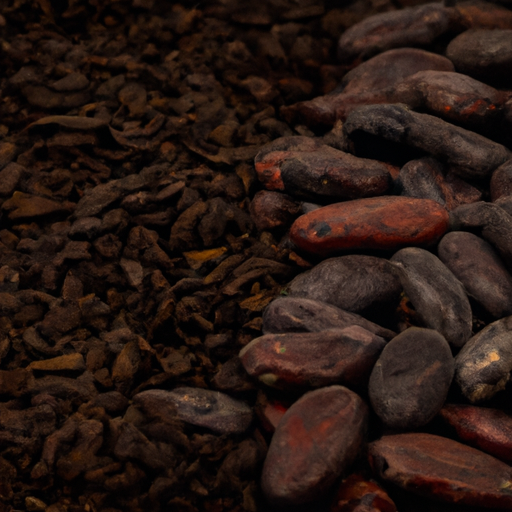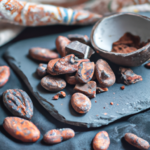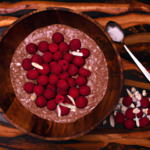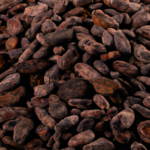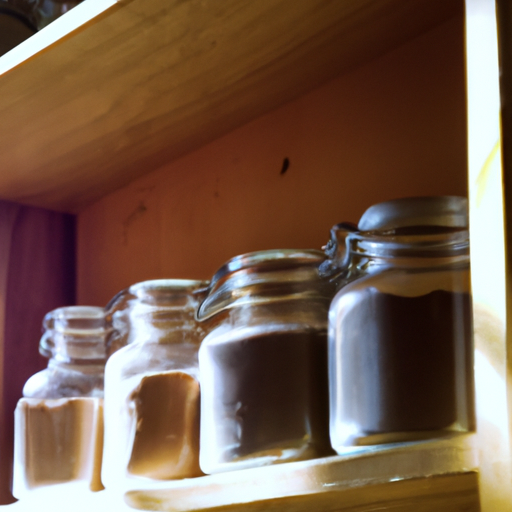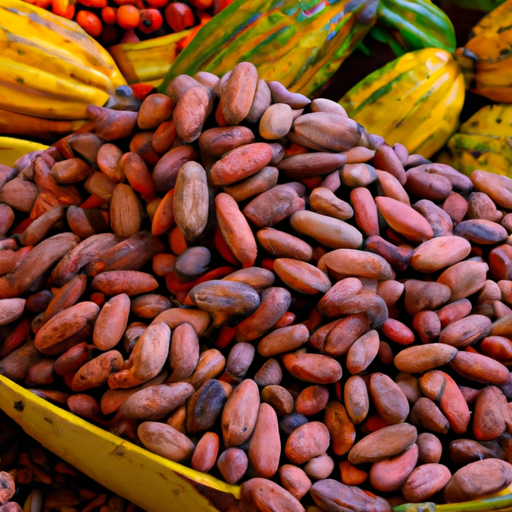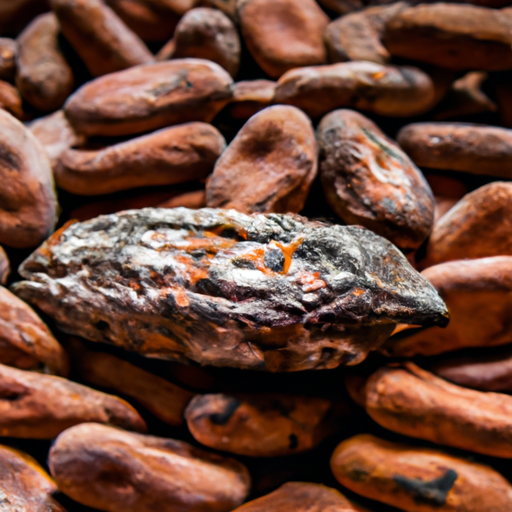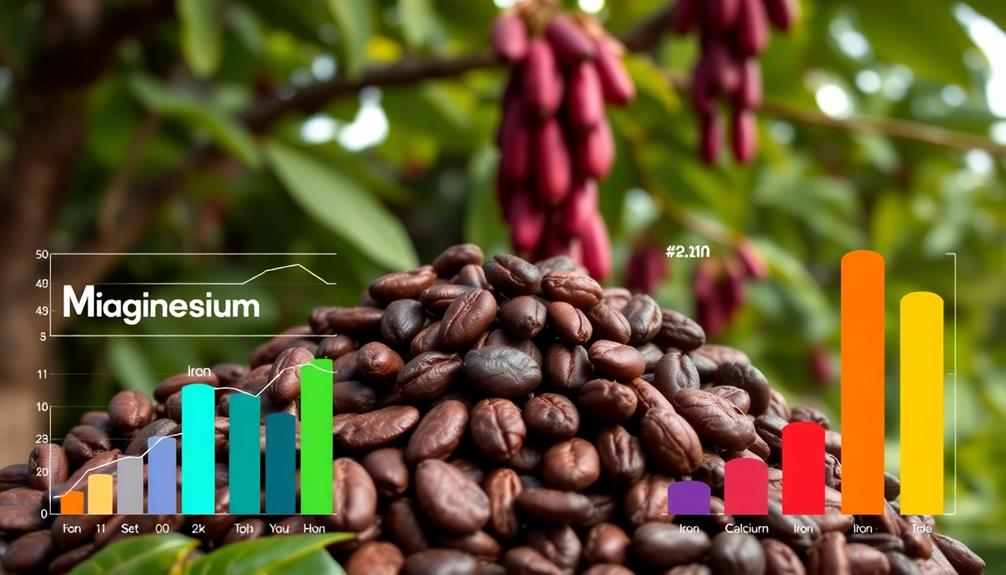Have you ever thought about whether raw or cooked cacao nibs are superior? You’ve come to the right place because in this article, I will explore the realm of cacao nibs and analyze the advantages and disadvantages of consuming them in their raw and cooked states.
Both raw and cooked cacao nibs have their own unique characteristics, flavors, and nutritional profiles. By exploring the process of making raw and cooked cacao nibs, as well as conducting a flavor and texture comparison, we can gain a better understanding of which option may be more suitable for our taste buds and health goals.
Additionally, we will discuss the potential health benefits of cacao nibs and consider important factors to help you make an informed decision.
So, let’s embark on this chocolatey journey and find out whether raw or cooked cacao nibs reign supreme!
Key Takeaways
- Both raw and cooked cacao nibs contain beneficial compounds and antioxidants.
- Raw cacao nibs have higher antioxidant content, more bitter taste, retain more nutrients, and are less processed.
- Cooked cacao nibs have enhanced flavor, reduced bitterness, potential loss of nutrients, and improved digestibility.
- The decision between raw and cooked cacao nibs depends on individual needs and preferences.
What are Cacao Nibs?
So, what exactly are cacao nibs? Well, they’re these little crunchy bites of goodness that come from the cacao bean. They’re packed with flavor and nutrients. Cacao nibs are essentially small pieces of crushed cacao beans. They have been roasted and separated from their outer husks. They are known for their rich chocolate flavor. They are often used as a healthy alternative to chocolate chips in baking or as a topping for desserts and smoothie bowls.
When it comes to the difference between raw and cooked cacao nibs, the main distinction lies in the processing method. Raw cacao nibs are made by simply crushing the cacao beans without any heat treatment. Cooked cacao nibs, on the other hand, undergo a roasting process.
Now, let’s dive into the process of raw cacao nibs.
The Process of Raw Cacao Nibs
When it comes to discussing the process of making raw cacao nibs, it’s important to understand that they are made from the beans of the cacao tree.
The beans are carefully harvested, fermented, and dried before being ground into small pieces, which are then called cacao nibs.
As for the benefits of raw cacao nibs, they are rich in antioxidants, fiber, and minerals such as magnesium and iron.
They are also known to boost mood, improve heart health, and provide a natural energy boost.
How Raw Cacao Nibs are Made
Raw cacao nibs are made by simply crushing cacao beans into tiny, flavorful pieces. The processing methods used for raw cacao ensure that the nibs retain their nutrients and flavors. Unlike roasted cacao beans, which are exposed to high temperatures that can diminish their nutritional value, raw cacao nibs are processed at lower temperatures to preserve their nutrients. This minimal processing allows the nibs to retain antioxidants, magnesium, iron, and other beneficial compounds. Raw cacao nibs have a more intense and complex flavor compared to roasted beans. These nutrient-rich morsels can be used in various culinary creations, adding a delicious and nutritious twist to recipes such as smoothies and baked goods.
Benefits of Raw Cacao Nibs
Indulge in the delectable benefits of raw cacao nibs. They provide a burst of natural goodness that will leave your taste buds craving for more.
Raw cacao nibs are packed with nutrients and antioxidants, making them a healthy addition to your diet. They contain high levels of magnesium, which supports heart health and helps regulate blood pressure.
Additionally, raw cacao nibs are a good source of fiber, iron, and flavonoids. These compounds have been linked to improved cognitive function and mood enhancement.
However, it is important to note that consuming excessive amounts of raw cacao nibs can have potential side effects. These include digestive issues and increased heart rate due to their caffeine content.
To reap the benefits, it is recommended to consume raw cacao nibs in moderation. A serving size of about one to two tablespoons per day is ideal.
Now, let’s transition into the subsequent section about the process of cooked cacao nibs and explore how they differ from their raw counterparts.
The Process of Cooked Cacao Nibs
If you want to understand the process of cooked cacao nibs, you should explore the theory and its visual representation.
The process starts with the raw cacao nibs being carefully selected and cleaned. Then, they are roasted at a specific temperature for a certain duration to enhance their flavor. During the roasting process, the nibs undergo chemical changes that result in the development of rich, complex flavors. This includes the Maillard reaction, which creates browning and caramelization.
Additionally, the roasting process reduces the bitterness of the nibs, making them more palatable. The roasted cacao nibs are then cooled and crushed into smaller pieces. The resulting nibs can be used in various culinary applications.
Transitioning into the subsequent section about flavor profile comparison, the roasting process plays a crucial role in shaping the taste of cooked cacao nibs.
Flavor Profile Comparison
As I savor the final product, the distinct flavors of raw and cooked cacao nibs dance on my palate, each with its own unique characteristics. The flavor intensity of raw cacao nibs is bold and vibrant, with a slightly bitter taste and hints of fruity and floral notes. On the other hand, cooked cacao nibs have a smoother and more mellow flavor profile, with a subtle sweetness and a rich, chocolatey taste. The cooking methods used for cacao nibs, such as roasting or grinding, can greatly influence the flavor profile. Roasting brings out the nutty and toasty flavors, while grinding intensifies the chocolatey notes. As we transition into the subsequent section about texture comparison, it is clear that the flavor profiles of raw and cooked cacao nibs offer a wide range of possibilities for indulging in the world of chocolate.
Texture Comparison
Moving on from the flavor profile, let’s now delve into the texture comparison between raw and cooked cacao nibs.
Texture plays a significant role in our overall taste preference. Raw cacao nibs have a crunchy and slightly bitter texture, providing a satisfying and intense bite. On the other hand, cooked cacao nibs have a smoother and softer texture due to the roasting process, which can be more appealing to some individuals.
It’s important to note that personal preferences for texture can vary greatly, and it ultimately depends on individual taste. When comparing the texture of raw and cooked cacao nibs, it’s essential to consider how it enhances the overall taste experience.
Now, let’s explore the nutritional comparison between these two forms of cacao to further understand their differences.
Nutritional Comparison
To fully understand the nutritional differences between raw and cooked cacao nibs, you may be wondering how these variations can impact your health and dietary choices. One important difference is the antioxidant levels. Raw cacao nibs have higher levels of antioxidants compared to cooked nibs. Antioxidants help protect your body against damage caused by harmful free radicals. Another consideration is the taste comparison. Raw cacao nibs have a more intense and bitter taste, while cooked nibs have a milder and sweeter flavor.
To better visualize the nutritional differences between raw and cooked cacao nibs, refer to the table below:
| Nutrient | Raw Cacao Nibs | Cooked Cacao Nibs |
|---|---|---|
| Antioxidants | High | Lower |
| Taste | Intense and bitter | Milder and sweeter |
Understanding the nutritional differences between raw and cooked cacao nibs can help you make informed dietary choices. In the next section, we will explore the potential health benefits of cacao nibs.
Potential Health Benefits
When it comes to potential health benefits, raw cacao nibs are known for their high antioxidant content. These antioxidants help fight against free radicals and reduce inflammation in the body, protecting it from oxidative stress.
Additionally, raw cacao nibs contain mood-boosting properties. This is due to their rich concentration of tryptophan, a precursor to serotonin, which is known as the ‘feel-good’ hormone.
So, incorporating raw cacao nibs into your diet could not only provide you with a healthy dose of antioxidants but also potentially uplift your mood.
Antioxidant Content
Although raw cacao nibs may have a higher antioxidant content, cooked cacao nibs still retain a significant amount of these beneficial compounds. Antioxidants are important for protecting the body against free radicals and reducing the risk of chronic diseases.
When comparing the antioxidant benefits of raw and cooked cacao nibs, it is essential to consider the processing methods. Here are four key points to understand:
- Heating cacao nibs during the cooking process may slightly reduce their antioxidant content.
- However, the overall antioxidant levels in cooked cacao nibs remain substantial and can still contribute to health benefits.
- The specific processing techniques used can affect the antioxidant content, so it is crucial to choose high-quality, minimally processed products.
- Regardless of whether you choose raw or cooked cacao nibs, both can be a valuable source of antioxidants for your diet.
Now let’s explore the mood-boosting properties of cacao nibs.
Mood-Boosting Properties
Boost your mood with the incredible properties of cacao nibs. Imagine feeling a surge of happiness and contentment after enjoying a small square of dark chocolate. Cacao nibs are not only delicious but also offer numerous benefits.
They contain certain compounds that can positively affect our mood and overall well-being. One of these compounds is phenylethylamine, often referred to as the ‘love drug’ because it can promote feelings of happiness and euphoria. Additionally, cacao nibs contain anandamide, a neurotransmitter that can enhance our mood and reduce anxiety.
There are different ways to consume cacao nibs. You can add them to smoothies, sprinkle them on top of yogurt or oatmeal, or use them as a topping for desserts. These versatile nibs are a tasty and convenient way to boost your mood.
Now, let’s explore the considerations for choosing between raw and cooked cacao nibs.
Considerations for Choosing Between Raw and Cooked Cacao Nibs
To make the best decision between raw and cooked cacao nibs, you need to consider the unique flavors and textures each option offers.
Flavor preferences play a significant role in choosing between raw and cooked cacao nibs. Raw cacao nibs have a more intense and bitter taste, while cooked cacao nibs are often sweeter and milder. The processing methods also affect the flavors.
Raw cacao nibs are made by simply crushing the beans, preserving more of their natural flavors. Cooked cacao nibs undergo a roasting process, which can alter the taste.
Additionally, textures differ between the two options. Raw cacao nibs are crunchier and have a nuttier texture, while cooked cacao nibs are slightly softer.
Consider your flavor preferences and desired texture when deciding between raw and cooked cacao nibs.
Transitioning to the next section, finding the best option for you involves considering other factors as well.
Conclusion: Finding the Best Option for You
After considering the various factors involved in choosing between raw and cooked cacao nibs, it is time to draw a conclusion and find the best option for you. Ultimately, the decision between raw and cooked cacao nibs comes down to personal preference. Both options have their own unique benefits and drawbacks, and what works for one person may not work for another.
To help you make an informed decision, I have created a table below that summarizes the key differences between raw and cooked cacao nibs. This table can assist you in finding the right choice based on your specific needs and preferences.
| Raw Cacao Nibs | Cooked Cacao Nibs |
|---|---|
| Higher antioxidant content | Enhanced flavor |
| More bitter taste | Reduced bitterness |
| Retains more nutrients | Potential loss of nutrients |
| Less processed | Improved digestibility |
By considering these factors and your personal taste preferences, you can find the perfect balance between health benefits and flavor when choosing between raw and cooked cacao nibs.
Frequently Asked Questions
Are there any potential risks or side effects associated with consuming cacao nibs?
While cacao nibs have potential health benefits, it’s important to be aware of potential risks. Some people may experience allergic reactions to cacao, so it’s wise to consume them in moderation and monitor any adverse effects.
Can raw or cooked cacao nibs be used interchangeably in recipes?
Raw and cooked cacao nibs can generally be used interchangeably in recipes. While there may be some slight differences in taste and texture, the nutritional content of raw and cooked cacao nibs is similar.
What is the recommended serving size for cacao nibs?
The recommended serving size for cacao nibs is about 1-2 tablespoons per day. These crunchy little delights are packed with health benefits, including antioxidants and essential minerals, making them a guilt-free indulgence.
Do raw or cooked cacao nibs have a higher antioxidant content?
Raw cacao nibs have a higher antioxidant content compared to cooked cacao nibs. Antioxidants are beneficial for health and can help protect against cellular damage. Both raw and cooked cacao nibs offer various health benefits.
Are there any differences in the environmental impact between raw and cooked cacao nib production?
When comparing the environmental impact of raw and cooked cacao nib production, it is crucial to analyze factors such as water and energy usage, waste generation, and carbon emissions. These production differences can have significant implications for sustainability and conservation efforts.
What are the benefits of consuming raw cacao nibs compared to cooked cacao nibs?
Raw cacao nibs benefits are numerous compared to their cooked counterpart. Raw cacao contains higher levels of antioxidants, enzymes, and nutrients that can be lost during the cooking process. Consuming raw cacao nibs can promote cardiovascular health, improve digestion, and boost mood and energy levels.
Conclusion
In conclusion, after carefully considering the flavor profile, texture, nutritional value, and potential health benefits, I have found that the best option for me is cooked cacao nibs.
The process of cooking enhances the flavor and brings out rich, chocolatey notes that perfectly complement my favorite desserts. The slightly crunchier texture adds a delightful surprise to every bite.
Additionally, the cooked cacao nibs retain their nutritional value, providing a good source of antioxidants and minerals.
So, next time I indulge in a decadent treat, I’ll choose the irresistible charm of cooked cacao nibs.

